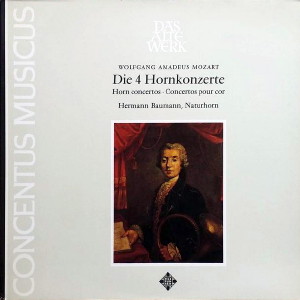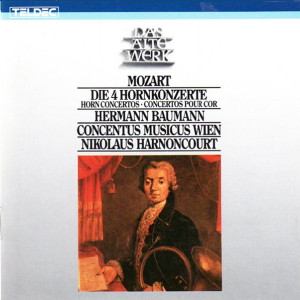 |
1 LP -
SAWT 9627-A - (p) 1974
|
 |
| 1 CD -
8.41272 ZK - (c) 1984 |
|
| Wolfgang
Amadeus Mozart (1756-1791) |
|
|
|
|
|
|
|
Konzert für Horn und
Orchester Nr. 3 Es-dur, KV 447
|
|
15' 07" |
A1 |
- Allegro *
|
7' 27" |
|
|
| - Romanze. Larghetto |
4' 18" |
|
|
| - Allegro |
3' 30" |
|
|
| Konzert für Horn und
Orchester Nr. 2 Es-dur, KV 417 |
|
13' 21" |
A2 |
| - Allegro maestoso |
6' 31" |
|
|
| - Andante |
3' 22" |
|
|
| - Rondo |
3' 28" |
|
|
| Konzert für Horn und
Orchester Nr. 1 D-dur, KV 412 & 514
(386 b) |
|
8' 48" |
B1 |
| - (Allegro) |
4' 50" |
|
|
| - Allegro (KV 514) |
3' 57" |
|
|
| Konzert für Horn und
Orchester Nr. 4 Es-dur, KV 495 |
|
16' 14" |
B2 |
- Allegro moderato *
|
8' 31" |
|
|
- Romanza. Andante
|
4' 01" |
|
|
- Rondo. allegro vivace
|
3' 38" |
|
|
|
|
|
|
Hermann Baumann,
Naturhorn und Kadenzen *
|
|
|
|
CONCENTUS MUSICUS
WIEN (mit Originainstrumenten)
|
|
| -
Alice Harnoncourt, Violine |
-
Peter Waite, Viola |
|
| -
Lars Fryden, Violine |
-
Nikolaus Harnoncourt, Violoncello |
|
| -
Peter Schoberwalter, Violine |
-
Eduard Hruza, Violone |
|
| -
Wilhelm Mergl, Violine |
-
Jürg Schaeftlein, Oboe |
|
| -
Erwin Spuller, Violine |
-
Paul Hailperin, Oboe |
|
| -
Walter Pfeiffer, Violine |
-
Wolfgang Rühm, Klarinette |
|
| -
Josef de Sordi, Violine |
-
Gerhard Totzauer, Klarinette |
|
| -
Ferdinand Svatek, Violine |
-
Othmar Berger, Horn |
|
| -
Peter Katt, Violine |
-
Hermann Rohrer, Horn |
|
| -
Kurt Weidenholzer, Violine |
-
Milan Turkovic, Fagott |
|
| -
Kurt Theiner, Viola |
-
Otto Flesichmann, Fagott |
|
|
|
| Nikolaus Harnoncourt, Leitung |
|
|
Luogo
e data di registrazione
|
| Bayerischer
Hof, Vienna (Austria) - novembre e
dicembre 1973 |
|
Registrazione
live / studio
|
| studio |
Producer
/ Engineer
|
-
|
Prima Edizione CD
|
Teldec
"Das Alte Werk" - 8.41272 ZK - (1 cd) -
53' 30" - (c) 1984 - AAD
|
Prima
Edizione LP
|
Telefunken "Das
Alte Werk" - SAWT
9627-A - (1 lp) - 53'
30"
- (p) 1974
|
|
|
Notes
|
Mozart’s
horn concertos were composed for what
is today practically an unknown
instrument: the natural horn which, as
opposed to the modern chromatic French
horn (valve horn), has no valve
mechanism. The player has to produce
the halfnotes, which do not exist in
the natural tone range, by
muting (i.e., pressing the hand or fist
into the bell). The “muted” tones of
the natural horn are more colourful,
the open ones far more sonorous than
is the case with modern valved
instruments. While
Mozart demands the utmost of the
interpreter with this performing
technique, he nevertheless at the same
time opens up a wealth of new
possibilities of expression. In
addition to bravura, in addition to
joyful hunting horn themes (final rondi),
Mozart also frequently underlines with
particular affection the other
characteristic side of the horn: the
gentle cantabile which, with its
manifold range of colours, results in
veritable miracles of melody.
Mozart’s horn concertos are
occasional works, almost all of them
(excepting perhaps No. 3 KV 447)
being composed for Joseph - not Ignaz -
Leutgeb (1732-1811). Leutgeb or
Leitgeb, as Mozart writes) was one
of the oldest friends of the Mozart
family; in 1763 he was employed at
the Salzburg court orchestra as
French hornist. In
1777 he moved to Vienna, where he
settled down as a cheese
dealer. Ten years later, as French
hornist with Prince Grassalkovich,
he was accepted as a member of the
Musicians Society. He appears to
have been constantly urging Mozart
to write new compositions for him;
Mozart for his part was in the habit
of treating him as a kind of house
jester. We have to thank this
strange friendly relationship for
some of the most beautiful works that were ever
composed for the horn.
Wolfgang Plath
English translation by
Frederick A. Bishop
|
|
Nikolaus
Harnoncourt (1929-2016)
|

|

|
|